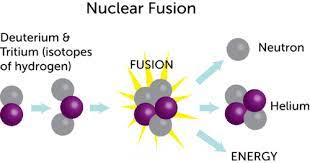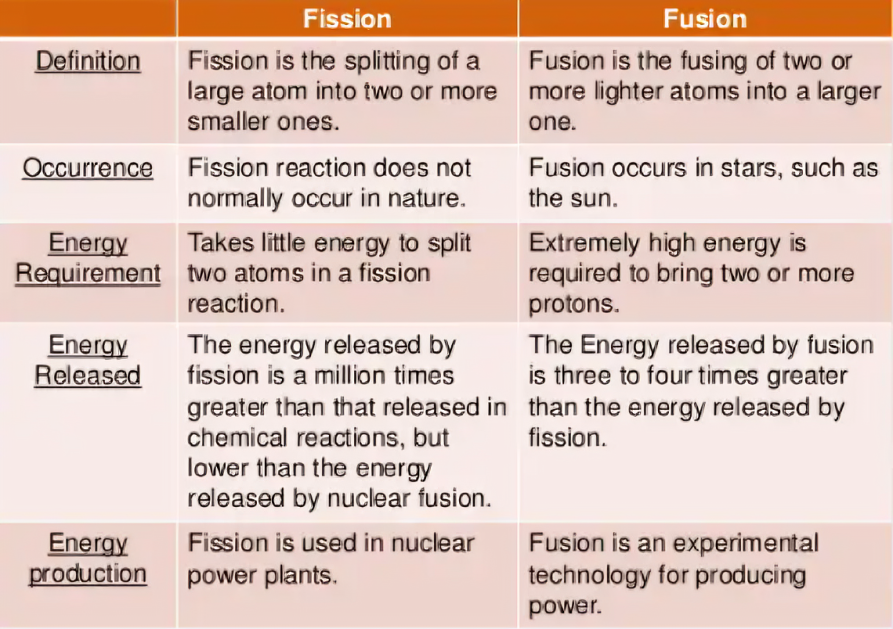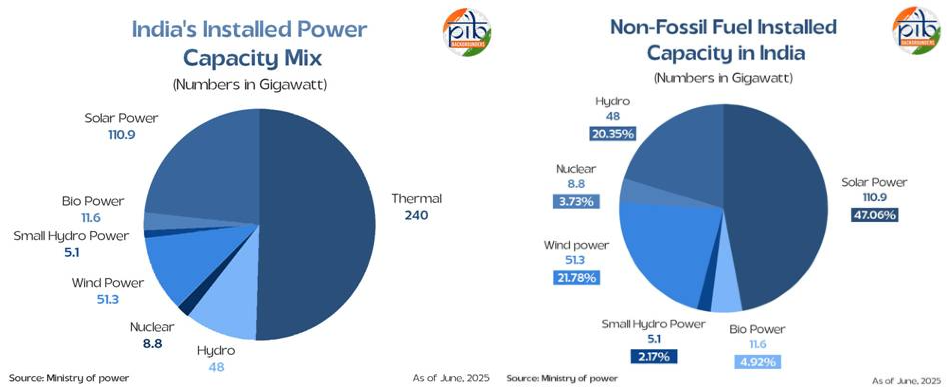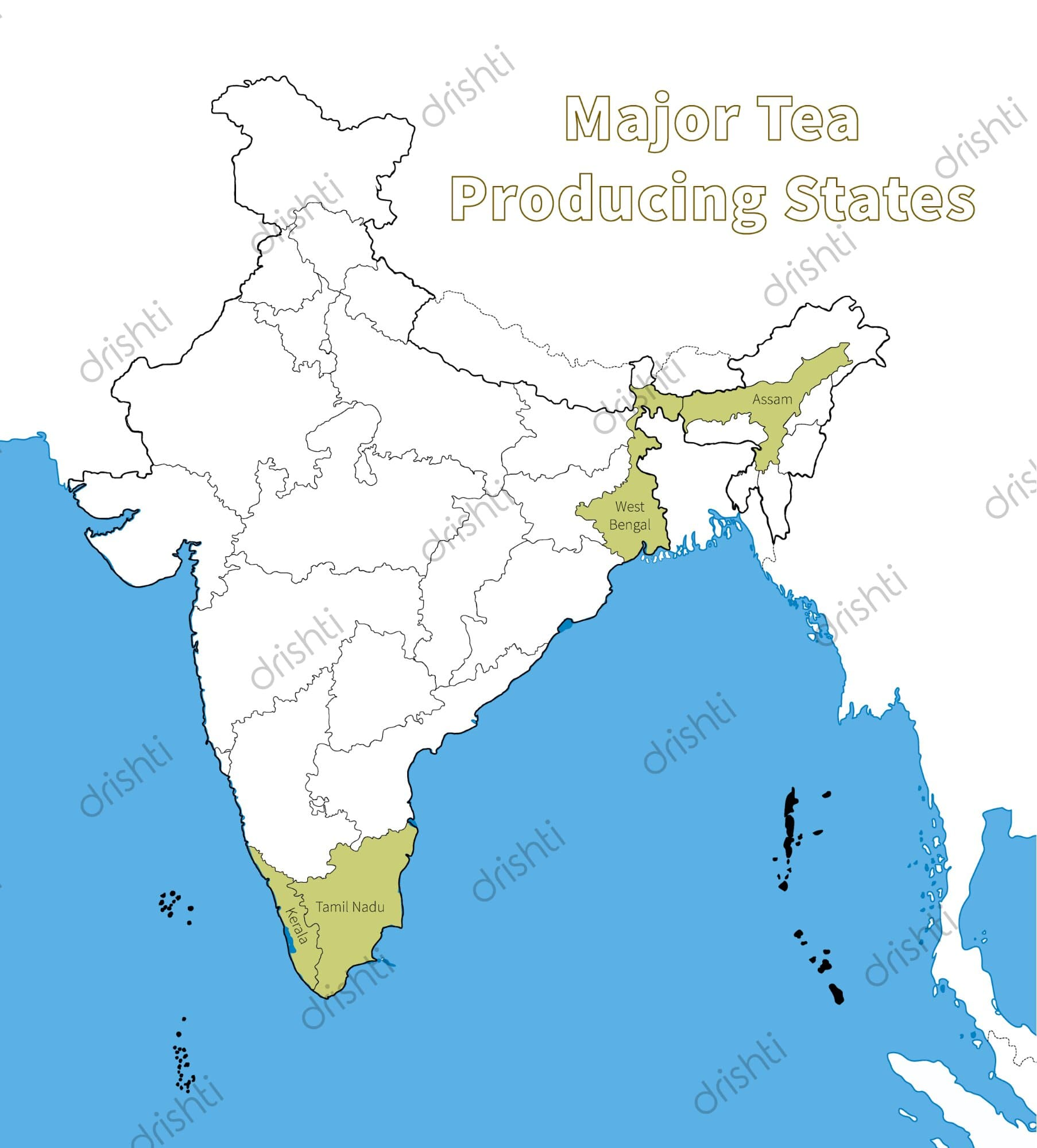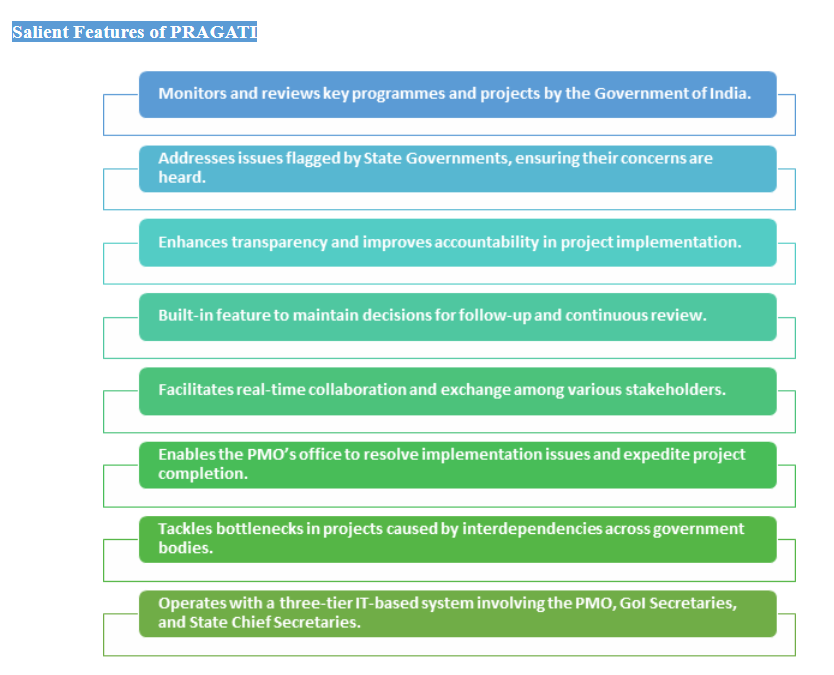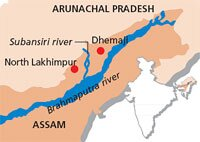India’s Roadmap for Fusion Power
For Prelims: Nuclear fusion, Difference between Nuclear Fusion & Nuclear Fission.
For Mains: Strategic significance of fusion research for India’s technological autonomy,
Why in News?
Researchers at the Institute for Plasma Research (IPR), Gandhinagar, proposes a roadmap for India’s fusion power, focusing on the development of the Steady-state Superconducting Tokamak-Bharat (SST-Bharat) reactor, marking a major step in India’s energy strategy.
What is Fusion?
- About: Fusion is the process where two small, light atoms (like hydrogen isotopes) come together to form a bigger, heavier atom, releasing vast amounts of energy. This is the energy process that powers the Sun and stars.
- For example, in the Sun, hydrogen nuclei fuse to form helium and release energy in the form of light and heat.
- Energy Release: The fusion of nuclei releases energy because the fused product has less mass than the sum of the individual atoms. This "lost" mass, known as the mass defect, is converted into energy according to Einstein's theory of special relativity (E=mc²).
- Conditions for Fusion:
- High Temperature: Around 100 million°C.
- High Pressure: Forces atoms nuclei close enough to fuse.
- Plasma: The material is in a high-energy state where atoms are broken into ions and electrons.
- Tokamaks: A tokamak is a fusion reactor that uses magnetic fields to confine and control plasma within a doughnut-shaped vessel. Its effectiveness is measured by how long it can hold the plasma without dissipation.
- Longer confinement times bring reactors closer to achieving continuous and reliable fusion reactions.
- Q Value (Energy Gain Factor): The Q value measures the efficiency of a fusion reactor.
- It is the ratio of output energy to input energy. A Q value > 1 means the reactor produces more energy than it consumes.
- Fusion vs Fission: Fission is the process used in nuclear reactors. In fission, a heavy nucleus (like uranium) splits into smaller nuclei, releasing energy.
- Fusion, on the other hand, combines lighter nuclei to release energy. Fusion produces much less radioactive waste than fission, making it a more attractive option for clean energy.
What is India’s Roadmap for Fusion Power?
- India’s Current Fusion Capabilities: India’s Steady State Superconducting Tokamak (SST-1) at IPR has achieved plasma confinement for 650 milliseconds (and it’s designed to go up to 16 minutes), however it is not designed for electricity generation but serves as an experimental base.
- India is already part of the International Thermonuclear Experimental Reactor (ITER) project in France, the world’s largest fusion experiment using magnetic confinement techniques. ITER aims to achieve a Q value of 10.
- SST-Bharat: SST-Bharat is planned as the next step beyond experiments, aimed at producing actual electricity.
- The SST-Bharat Vision aims to initially build a 130 MW fusion-fission hybrid reactor with a Q value of 5.
- The team plans to commission a full-scale demonstration reactor by 2060, targeting an ambitious output-to-input power ratio (Q) of 20 and generating 250 MW.
- Technology Measures:
- Digital twins: Virtual replicas of tokamaks to simulate conditions and test designs.
- Machine learning: Leveraging artificial intelligence and machine learning helps in predicting and managing plasma behavior, crucial for better plasma confinement.
- Development of Radiation-Resistant Materials: Focus on designing materials that can withstand the extreme radiation levels in fusion reactors.
- Superconducting Magnets: Research into high-performance superconducting magnets to create stronger magnetic fields for better plasma confinement.
Global Advances in Fusion Power
- United Kingdom: UK STEP programme aims for a prototype fusion power plant by 2040.
- US: Several private firms claim they will deliver grid-connected fusion power in the 2030s.
- China: China’s Experimental Advanced Superconducting Tokamak (EAST) tokamak has already set records for plasma holding duration (for about 1,066 seconds).
What are the Challenges for India’s Roadmap for Fusion Power?
- High Costs: Fusion research requires significant investment in advanced technology, infrastructure, and reactors, putting pressure on India’s public-sector budget.
- Long Development Timeline: India’s target of 2060 for a fusion reactor is slower compared to global efforts, making the path to commercialization longer.
- Countries like China and the US are progressing faster with fusion, putting pressure on India to keep pace.
- Limited Private Sector Involvement: Unlike the US and EU, India’s private sector plays a smaller role in fusion research, slowing innovation and progress.
- Technological Hurdles: Challenges include plasma containment, achieving the necessary energy gain (Q value), and developing radiation-resistant materials, which complicate fusion’s realization.
- Competition with Other Energy Sources: Fusion competes with solar, wind, and nuclear fission, while India’s broader energy commitments, such as net-zero by 2070, may divert focus.
- Uncertain Commercial Viability: Even if fusion succeeds, its cost-effectiveness compared to existing energy sources remains uncertain.
How can India Ensure Strategic Gains from Investing in Fusion Power R&D?
- Policy and Funding Support: Allocate long-term, mission-mode funding, akin to ISRO or nuclear fission missions.
- Involve private-sector partnerships, especially in advanced materials, AI, and digital simulations.
- Global Collaborations: Expand engagements beyond ITER, include bilateral partnerships with fusion labs in the US, UK, and EU.
- Participate in international fusion data sharing initiatives and joint training of Indian scientists.
- Realistic Targeting: Fusion energy should be seen as a strategic R&D frontier, not a near-term energy source.
- Align milestones with global benchmarks but prioritize indigenous innovation and technology localization.
- Leveraging Fusion R&D for Broader Advancements: Use fusion research to enhance capabilities in superconducting materials, radiation shielding, plasma control, and AI-driven simulations.
- Strengthen India’s independence in key sectors like defense and space technology through innovations from fusion research.
Conclusion
India’s fusion roadmap is ambitious but cautious, aiming for a 2060 demonstration plant while the UK, US, and China target earlier prototypes. Though costly and uncertain, it could yield valuable technological and strategic gains for India’s energy future.
|
Drishti Mains Question: Q. Fusion power is often described as the ‘holy grail’ of clean energy. Critically analyze the opportunities and challenges of adopting fusion in India’s energy mix. |
UPSC Civil Services Examination, Previous Year Questions (PYQs)
Prelims
Q. The function of heavy water in a nuclear reactor is to (2011)
(a) Slow down the speed of neutrons
(b) Increase the speed of neutrons
(c) Cool down the reactor
(d) Stop the nuclear reaction
Ans: (a)
Mains
Q. With growing energy needs should India keep on expanding its nuclear energy programme? Discuss the facts and fears associated with nuclear energy. (2018)
The Production Gap Report 2025
Why in News?
The Production Gap 2025 report reveals that countries plan to produce more fossil fuels in 2030 than required to limit global warming to 1.5°C (Paris Agreement). It highlights that production plans have increased since 2023, widening the gap between current policies and the actions needed to meet climate goals.
The Production Gap Report 2025
- It is published by Stockholm Environment Institute (SEI), Climate Analytics, and the International Institute for Sustainable Development (IISD), and backed by the UN.
- It tracks the discrepancy between governments’ planned fossil fuel production and global production levels needed to limit global warming to 1.5°C or 2°C.
- 2025 Edition marks the fifth edition of the report, which was first released in 2019. This edition updates the analysis presented in the 2023 report.
What are the Key Findings of the Production Gap Report 2025?
- Rising Coal Demand: Coal continues to be the most misaligned, with projected global output in 2030 being 500% higher than what the 1.5°C pathway allows.
- India launched the Coal Gasification Mission in 2020, aiming to gasify 100 million tonnes of coal by 2030.
- Coal gasification is a thermo-chemical process that converts coal into synthesis gas or "syngas", primarily consisting of carbon monoxide and hydrogen.
- India launched the Coal Gasification Mission in 2020, aiming to gasify 100 million tonnes of coal by 2030.
- Rise in Fossil Fuel Production: Planned fossil fuel production in 2030 is set to surpass levels required to limit warming to 1.5°C by over 120% and to 2°C by 77%.
- Governments plan higher coal production to 2035 and gas production to 2050 than in 2023. Oil production is also projected to increase to 2050.
- In 2023, the government provided Rs 726 billion in oil and gas subsidies and aims to increase gas's share in the energy mix from 6.2% to 15% by 2030.
- Major Contributors: China, the US, and Russia accounted for over half of global extraction-based emissions from fossil fuels in 2022, while 20 major producers contributed around 80% of global production.
- Limited Alignment with Climate Targets: Among 20 major producers, 17 plan to increase at least one fossil fuel by 2030, and 11 countries (including China, India, US, Germany) plan higher production than in 2023.
- Only 6 countries are aligning fossil fuel production with net-zero targets (up from 4 in 2023).
How can India Balance Fossil Fuel Production with Renewable Energy?
Mnemonic: GRIDS
- G - Grid Infrastructure Modernization: Invest in energy storage (batteries, pumped hydro) and green energy corridors to store and transmit solar and wind power, reducing reliance on fossil fuels.
- R - Reskill Workers: Reskill coal sector workers in states like Jharkhand, Chhattisgarh, and Odisha and repurpose former mining areas for solar parks or industrial uses to support a socially acceptable energy transition.
- I - Increase Energy Efficiency: Enforce strict energy efficiency standards and promote demand response programs to reduce overall energy demand and balance the grid with abundant solar power. E.g., Perform, Achieve and Trade (PAT) Scheme.
- D - Develop Natural Gas as a Bridge Fuel: Increase the natural gas share from 6.2% to 15% by 2030, leveraging flexible gas plants that emit 50% less CO₂ than coal to support renewables and reduce emissions.
- S - Sustainability through Policy Integration: Align fossil fuel reduction targets with renewable energy goals using carbon pricing, renewable subsidies, and phasing out inefficient fossil fuel subsidies.
India’s Initiatives to Reduce Dependence on Fossil Fuels
Conclusion
The Production Gap Report 2025 reveals a dangerous contradiction: despite climate commitments, countries are expanding fossil fuel production, prioritizing short-term energy security and economic growth. This path undermines the Paris Agreement, locks in catastrophic warming, and necessitates an urgent, equitable global transition to clean energy.
|
Drishti Mains Question: Q. Discuss the reasons behind continued expansion of fossil fuel production despite the Paris Agreement commitments. |
UPSC Civil Services Examination, Previous Year’s Question (PYQs)
Prelims
Q. The term ‘Intended Nationally Determined Contributions’ is sometimes seen in the news in the context of (2016)
(a) pledges made by the European countries to rehabilitate refugees from the war-affected Middle East
(b) plan of action outlined by the countries of the world to combat climate change
(c) capital contributed by the member countries in the establishment of Asian Infrastructure Investment Bank
(d) plan of action outlined by the countries of the world regarding Sustainable Development Goals
Answer: (b)
Q. With reference to the Agreement at the UNFCCC Meeting in Paris in 2015, which of the following statements is/are correct? (2016)
- The Agreement was signed by all the member countries of the UN and it will go into effect in 2017.
- The Agreement aims to limit the greenhouse gas emissions so that the rise in average global temperature by the end of this century does not exceed 2°C or even 1.5°C above pre-industrial levels.
- Developed countries acknowledged their historical responsibility in global warming and committed to donate $1000 billion a year from 2020 to help developing countries to cope with climate change.
Select the correct answer using the code given below.
(a) 1 and 3 only
(b) 2 only
(c) 2 and 3 only
(d) 1, 2 and 3
Answer: (b)
Mains
Q1. Discuss global warming and mention its effects on the global climate. Explain the control measures to bring down the level of greenhouse gases which cause global warming, in the light of the Kyoto Protocol, 1997. (2022)
Q2. Describe the major outcomes of the 26th session of the Conference of the Parties (COP) to the United Nations Framework Convention on Climate Change (UNFCCC). What are the commitments made by India in this conference? (2021)
India's Tea Industry
Why in News?
According to the Executive Director of the International Tea Committee, India has the potential to become a global tea superpower, supported by its strong production capacity, large consumption base, and growing export opportunities.
Current Status of India’s Tea Market
- Major Producers: India ranks as the 2nd largest producer and consumer of tea and the 3rd largest exporter. Kenya, the top exporter, ships nearly all its output, while China is the 2nd largest exporter.
- Tea Producing Regions: In India, major tea growing states are Assam (Assam valley and Cachar), West Bengal (Dooars, Terai and Darjeeling), Tamil Nadu and Kerala that account for about 96% of the total tea production.
- Consumption: India is a top tea-consuming country, using 80% of its production domestically, with a per capita consumption of 840 gm/year (Highest: Turkey, 3 kg/year).
- Exports: India exports tea to over 25 countries, with major importers including Russia, Iran, UAE, USA, UK, Germany, and China.
- About 96% of India’s tea exports is black tea, with other exported types including regular, green, herbal, masala, and lemon tea.
What are the Key Facts Regarding Tea?
- About: Tea is a beverage made from the Camellia sinensis plant and is the world’s most consumed drink after water.
- Tea Board of India: Established under the Tea Act of 1953, it is a statutory body under the Ministry of Commerce with its head office in Kolkata and overseas offices in London, Dubai, and Moscow.
- Provides financial and technical support for the cultivation, production, and marketing of tea.
- Growth Conditions:
- Climate: Tea is a tropical and sub-tropical crop that thrives in hot, humid conditions.
- Temperature: It grows best between 20°–30°C, while temperatures above 35°C or below 10°C can damage the plant.
- Rainfall: Requires 150–300 cm of well-distributed rainfall annually.
- Soil: Prefers slightly acidic, calcium-free soil with a porous sub-soil to allow free water percolation.
- Factors Contributing to the Crisis in Industry:
- Weather-Driven Decline: Extreme heat in May 2024 followed by flooding in Assam cut India’s tea production by 30% to 90.92 million kg, its lowest in over a decade.
- Supply-Demand Imbalance: There is a growing gap between the demand for tea and its supply, creating further pressure on the industry.
- Stagnant Prices: Assam, which accounts for 55% of India’s tea production, has been particularly affected by stagnant prices.
Intense Competition: India is facing stiff competition from other major tea-producing countries like Kenya. - Rising Input Costs: Over the past decade, the costs of essential inputs have increased by 9-15%, while tea prices have only risen by 4%.
- The ban on 20 pesticides raised tea prices due to costly alternatives further straining the profitability of the sector.
How can India Ensure the Sustainability of its Tea Industry?
- Shift to Quality & Value Addition: Promote GI-tagged, specialty, and branded teas for better export prices.
- Diversify Export Markets: Target South America, Middle East, and Africa to reduce reliance on volatile markets.
- Boost Domestic Consumption: Increase per capita intake through marketing, ready-to-drink (RTD), flavored, and wellness teas.
- Improve Farm-Gate Value: Ensure small growers receive a fairer share via direct markets, Farmer Producer Organizations, (FPOs), and transparent auctions.
- Learning from Other Countries: Equip farmers to produce high-quality, sustainable tea; Kenya’s Farmer Field Schools (FFSs) provide hands-on training in planting, fine-plucking, and certification preparation.
Conclusion
The Indian tea industry stands at a crossroads, balancing its global potential against severe challenges like climate vulnerability and low value realization. Achieving sustainable profitability requires a strategic shift from volume to quality, empowering small growers, and innovating for both export and domestic markets.
|
Drishti Mains Question: Q. Examine the current status and challenges of India’s tea industry and suggest measures for its sustainability. |
UPSC Civil Services Examination Previous Year Question (PYQ)
Prelims
Q. With reference to the "Tea Board" in India, consider the following statements: (2022)
- The Tea Board is a statutory body.
- It is a regulatory body attached to the Ministry of Agriculture and Farmers Welfare.
- The Tea Board's Head Office is situated in Bengaluru.
- The Board has overseas offices at Dubai and Moscow.
Which of the statements given above are correct?
(a) 1 and 3
(b) 2 and 4
(c) 3 and 4
(d) 1 and 4
Ans: (d)
Mains
Q. Whereas the British planters had developed tea gardens all along the Shivaliks and Lesser Himalayas from Assam to Himachal Pradesh, in effect they did not succeed beyond the Darjeeling area. Explain. (2014)
Defamation
Why in News?
A judge of the Supreme Court of India highlighted the need to decriminalise defamation, citing concerns over its increasing misuse by political leaders and private individuals to settle personal and political disputes.
What is Defamation?
- About: Defamation is the act of speaking, writing, publishing, or making signs against someone with the intention to harm their reputation.
- It can concern a living person, a company, association, or group, or a deceased individual, with harm to the deceased considered in terms of its impact on their family or close relatives.
- Types of Defamation:
- Libel: Defamatory statements made in a permanent form, e.g., writing, images, published works.
- Slander: Defamation through spoken words or temporary expressions.
- Courts interpret defamation subjectively, based on proof and circumstances.
- Regulation in India:
- Indian Penal Code (IPC) Sections 499 & 500 (now Bharatiya Nyaya Sanhita, 2023): Defines defamation and prescribes its punishments.
- Defamation can be criminal or civil, depending on severity and evidence. Criminal cases require strong proof and the presence of reasonable doubt.
- Criminal defamation serves as a stronger deterrent than civil penalties, upholds public interest in protecting reputation, and safeguards vulnerable groups from discrimination or hate speech.
- Indian Penal Code (IPC) Sections 499 & 500 (now Bharatiya Nyaya Sanhita, 2023): Defines defamation and prescribes its punishments.
- Judicial Pronouncement:
- Subramanian Swamy Vs. Union of India, 2016: The upheld the constitutional validity of criminal defamation. It ruled that protecting reputation is part of the fundamental right to life under Article 21.
- Criminal defamation under IPC was held to be a “reasonable restriction” on free speech under Article 19(2).
- Article 19(2) of the Indian Constitution permits the State to impose “reasonable restrictions” on the right to freedom of speech and expression.
- Subramanian Swamy Vs. Union of India, 2016: The upheld the constitutional validity of criminal defamation. It ruled that protecting reputation is part of the fundamental right to life under Article 21.
What is the Need to Decriminalise Defamation?
- Prevent Misuse: Criminal defamation is often used by individuals or political figures to settle personal or political scores.
- Protect Freedom of Speech: Criminal defamation threatens free speech and press freedom. Decriminalisation would reduce the chilling effect on journalists, activists, and citizens expressing opinions.
- Civil Remedies are Sufficient: Reputation can still be protected through civil defamation suits without criminal penalties. Many democracies like the US treat defamation as a civil matter rather than a criminal offense.
- Reputational harm is a civil injury; imprisonment is excessive and violates the principle of proportionality.
- Judicial Economy: Criminal cases add to the already massive backlog in courts; civil remedies are more efficient and less burdensome.
What Measures Can Strengthen Defamation Laws While Protecting Free Speech in India?
- Decriminalise Private Defamation: Restrict criminal liability only to matters of public interest or national security, shift private disputes to civil law.
- Strengthen Civil Remedies: Fast-track courts for defamation cases, clear compensation norms, and alternative dispute resolution for quicker justice.
- Define Clear Standards: Re-examine the 2016 judgment in light of present misuse and provide judicial or legislative guidelines to distinguish fair criticism, satire, and irony from malicious defamation.
- Safeguard Press Freedom: Introduce protections for journalists, whistleblowers, and researchers acting in public interest.
- Prevent SLAPP Suits: Enact anti- strategic lawsuit against public participation (SLAPP) legislation to stop misuse of defamation cases by powerful individuals or corporations.
- Awareness & Media Literacy: Educate citizens on responsible speech and remedies available without resorting to criminal cases.
Conclusion
Defamation remains a complex issue where free speech and reputation often collide. Any change must weigh the risk of silencing criticism against the need to protect dignity, demanding cautious, well-researched reforms.
|
Drishti Mains Question: Q. Analyse the misuse of defamation laws and its impact on democratic discourse. |
UPSC Civil Services Examination, Previous Year Question (PYQ):
Mains
Q. What do you understand by the concept of “freedom of speech and expression”? Does it cover hate speech also? Why do the films in India stand on a slightly different plane from other forms of expression? Discuss. (2014)
International Seabed Authority's 8th Annual Contractors Meeting 2025
India hosted the 8th Annual Contractors’ Meeting of the ISA at CSIR-National Institute of Oceanography, Goa bringing global experts together to discuss deep-sea exploration.
- The meeting also emphasizes sustainable resource management, in line with India’s Deep Ocean Mission and the "common heritage of mankind" vision.
- The meeting highlighted India’s pioneering role in international seabed exploration. India was the first country to receive an area for polymetallic nodule (PMN) exploration in international waters and was designated as a “Pioneer Investor.”
- With two Polymetallic Sulphides (PMS) contracts with the ISA, one in the Central Indian Ridge & Southwest Indian Ridge and another in the Carlsberg Ridge of the Indian Ocean. India now holds the largest exploration area for PMS in the international seabed.
International Seabed Authority (ISA)
- The ISA, headquartered in Kingston, Jamaica, is an autonomous organization established under the 1982 UN Convention on the Law of the Sea (UNCLOS) and the 1994 Implementation Agreement.
- It regulates all mineral-resource activities in the international seabed for the benefit of humanity, with 170 member states, including India.
|
Read more: 30th anniversary of ISA |
PRAGATI
The Prime Minister chaired the 49th meeting of PRAGATI (Pro-Active Governance and Timely Implementation), focusing on expediting key infrastructure projects.
- PRAGATI: It is an innovative, Information and Communication Technologies (ICT)-enabled platform initiated in 2015 to ensure timely implementation of government projects, and redress public grievances.
- It facilitates Centre-State coordination, fostering the “Team India” approach and resolves inter-state disputes efficiently, bypassing red tapeism.
- Key Features: PRAGATI has a three-tier system (PMO, Union Government Secretaries, and Chief Secretaries of the States) for direct communication. Prime Minister-led oversight ensures timely decisions and swift resolution of bottlenecks.
- It combines video conferencing, geo-spatial mapping, drone feeds, and centralized data systems.
- It is integrated with the Centralised Public Grievance Redressal and Monitoring System, PM Gati Shakti, PARIVESH, and Project Monitoring Group portal, enabling real-time monitoring and predictive tracking.
- Impact: As of 2024, the PRAGATI platform has helped accelerate over 340 critical projects worth USD 205 billion.
- Improved implementation of Jal Jeevan Mission, Swachh Bharat Abhiyan, and Saubhagya Scheme, directly benefiting millions of citizens.
- Resolved citizen issues such as Employees' Provident Fund (EPF) payments, income tax refunds, and other public complaints, while improving systemic mechanisms to prevent recurrence.
|
Read more: PRAGATI |
Oju Hydel Project
The central government has granted environmental clearance to the Oju Hydroelectric Project in Arunachal Pradesh's Upper Subansiri district, paving the way for the construction of one of India's largest hydroelectric projects, near the China border.
- Oju Hydroelectric Project is a 2,220 MW run-of-river hydro project.
- It aims to tap into the Subansiri basin's vast hydropower potential, contributing significantly to India's renewable energy capacity.
- Significance: This is part of the infrastructure push in the North-East for hydropower development.
- The project is largest in the Subansiri basin, upstream of projects like Niare, Naba, Nalo, Dengser, Upper & Lower Subansiri, making it vital for basin-wide energy planning.
- Its proximity to the international border also enhances its significance in terms of energy security.
Subansiri River
- The Subansiri River, also known as the Gold River, is a Trans-Himalayan river.
- It originates from the western part of Mount Porom (5059 m) in the Tibetan Himalayas.
- It enters India through the Miri Hills in Arunachal Pradesh.
- As the longest tributary on the right northern bank of the Brahmaputra, the Subansiri merges with the Brahmaputra at Majuli Island in Assam, which is the largest river island in Asia.
|
Read More: Shubhansiri Dam Project |

